#tesla model s convertible
Text
Cars Love and Deepspace men would drive!
Happy valentine’s day everyone! Imagine the boys taking picking you up for a date🫶🏻
Had so much fun with this one because a big car girl so this one really resonated with me.

Zayne - Mercedes AMG GT63


Note: It HAS to be a sedan and all black.
Rafayel - Porsche 911 Carrera 4S Cabriolet

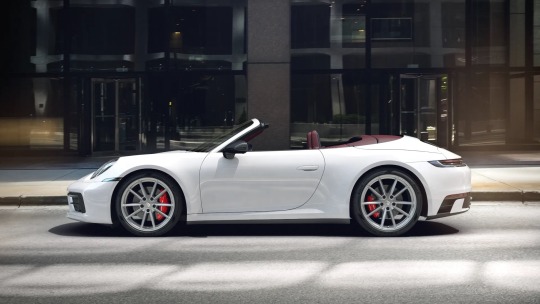
Note: It has to be a white convertible with red interior
Xavier - Tesla Model S
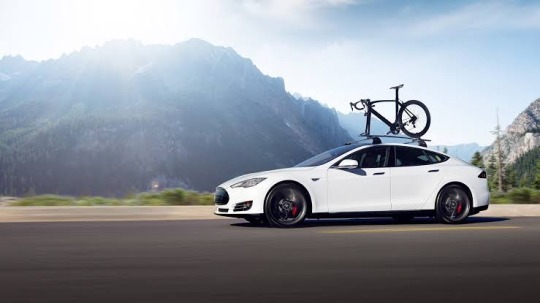

Note: He gives me small electric car vibes because wise he’d fall asleep anywhere and turn on autodrive
#love and deepspace headcanons#love & deepspace#love and deepspace x reader#love and deepspace#zayne#xavier#rafayel#lads zayne#lads#lads xavier#lads rafayel#zayne x reader#xavier x reader#rafayel x reader#zayne x you#rafayel x you#xavier x you#zayne headcanons#rafayel headcanons#xavier headcanons#zayne imagines#xavier imagines#rafayel imagines
268 notes
·
View notes
Text
New Yorkers looking to escape the winter chill by driving to Daytona Beach, Florida, would use about 40 gallons of gasoline to traverse the 1,000 miles in a Chevrolet Impala.
Switch that gas guzzler out for an electron-eating EV and the equation changes. A Tesla Model S traveling the same distance would need power generated by about 2,500 cubic feet of natural gas, 286 pounds of coal or 33 minutes of blades spinning on a giant offshore wind turbine to make the same journey.
Gas Guzzlers to Electron Eaters
Electric vehicles have a wide range of fuel mileage options
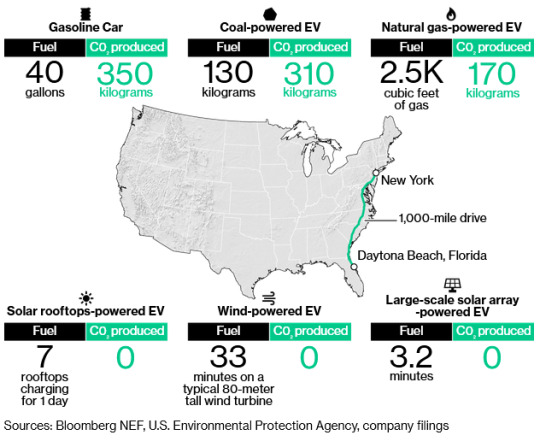
As electric vehicles slowly become a bigger part of the global automobile fleet, questions about mileage and fuel efficiency are going to become more apposite. While there are multiple variables that can affect electric vehicle energy consumption, a Bloomberg NEF analysis illustrated some ballpark estimates to give drivers a better picture of what’s happening underneath the hood.
Coal
Taking that same 1,000-mile road trip in an electric vehicle that needs 33 kilowatt-hours of energy to travel 100 miles, like a Tesla Model S, would require about 286 pounds (130 kilograms) of coal to be burned at the local power plant. Modern coal plants only convert about 35 percent of the fuel’s energy into electricity, and about 10 percent of that electricity could be lost as it travels along power lines.
Even with all those losses, the electric vehicle road trip is still better for the climate than driving a gasoline-powered car. Burning that much coal would release about 310 kilograms of carbon dioxide into the atmosphere, compared with 350 kilograms by the 40 gallons of gasoline. Even though coal tends to emit more pollutants than oil for the amount of energy it generates, the efficiency of the electric vehicle, which recharges its battery with every brake, more than makes up the difference.
Natural Gas
A natural gas power plant producing the same amount of electricity would need to burn about 2,500 cubic feet of the fuel, enough to fill a small apartment in Hong Kong or a master bedroom in Dallas. Gas plants are more efficient than coal, typically converting about half the fuel’s energy into electricity. It’s also much cleaner, emitting just 170 kilograms of carbon dioxide for the 1,000-mile journey.
Solar
When it comes to charging electric vehicles with solar power, size matters. A typical 10-kilowatt rooftop array would need about seven days to create enough electricity for a 1,000-mile journey, as clouds and darkness mean it only operates at about 20 percent of its capacity on an average day.
Scale up to a photovoltaic power station, though, and it would take a matter of minutes, not days. At a modest-sized solar field like the 25-megawatt DeSoto Next Generation Solar Center in Florida, the average daily output would produce enough electricity for a 1,000-mile drive in less than four minutes.
Wind
Wind is a similar story, with different sizes of turbines producing different amounts of electricity. Take the Vestas V90-2.0 MW, an 80-meter tall behemoth that can be found swirling on the plains of West Texas, among other locations. Just one of these turbines, and wind farms are usually planted with dozens of them, produces enough electricity in a day to power a 1,000-mile trip every 33 minutes.
Calculating carbon emissions from wind and solar is a bit trickier. Neither emit any carbon dioxide in the course of producing electricity on a daily basis. But unless they’re paired with adequate energy storage -- and most existing renewable generation isn’t -- carbon-emitting generation has to make up for them whenever the sun isn’t shining or the wind isn’t blowing.
2 notes
·
View notes
Text
Top 5 Luxury Car Rent Companies Dubai

Introduction: Dubai, a city famous worldwide for its luxury, offers options for those seeking to rent cars for their travel needs. There are various car rental agencies providing cars for daily life and tourism purposes to save expenses and time from public transportation. In this article, we will explore the top five car rental companies in Dubai, renowned for their exceptional service and diverse fleet of vehicles.
1 Renturdrive: Renturdrive is a premier online platform for luxury cars on rent in Dubai, catering to those who desire to explore the city in style. Featuring a fleet of the latest models from renowned brands like Lamborghini, Ferrari, and Rolls Royce, Rentur Drive offers a seamless rental experience. They connect customers with multiple reputable car agencies, simplifying the process of finding the perfect high-end vehicle. With flexible rental durations, Renturdrive accommodates all needs, from quick day trips to month-long adventures. Whether it's for business or leisure, Renturdrive ensures a luxurious and hassle-free journey throughout the Emirates. As one of the top luxury car rental Company in Dubai, Renturdrive stands out for its commitment to excellence and unparalleled service.
Services: Cheap Car on Rent, Luxury car on Rent, Daily car on rent, Weekly Car on Rent, Monthly car on rent
Address: Level 702, Building 6, Emaar Square, Burj Khalifa Community, Dubai PO BOX 122347
2 Al Emad: Al Emad is a car rental service provider in Dubai, offering cars for both tourist purposes and regular travel needs. They provide a variety of cars for rental, catering to the diverse needs and preferences of customers. From economy cars such as Toyota, Nissan, Kia, and Hyundai to luxury vehicles, Al Emad boasts a diverse fleet. Whether you require a car for the short or long term, they can assist you. Their vision is to offer these services to visitors and residents alike, making travel easier for everyone.
Services: offered include car rental in Dubai with options for monthly, luxury, cheap, and SUV rentals.
Location: Al Emad Cars JLT Office, Cluster I, Platinum Tower, Dubai, UAE.
3 UAEdriving: UAEdriving is your gateway to premier Luxury car rental and chauffeur services across the UAE, including Dubai, Abu Dhabi, and Sharjah. Offering hassle-free bookings through its network of trusted partners, UAEdriving ensures a seamless experience for every customer. Whether you need a luxurious car for a business trip or a chauffeur for a special occasion, UAEdriving delivers top-notch service and reliability. Experience the ease and comfort of premium services as UAEdriving connects you with the best in the business, making your travel stress-free and enjoyable.
Service: Car on Rent, Monthly Car on Rent, Car on Lease, Car With Driver,
Location: Opal Tower - Business Bay - Dubai - United Arab Emirates
4 X Car Rental: As one of the leading luxury car rental brands in Dubai, we take pride in offering an extensive variety of high-end vehicles. Our fleet includes prestigious names like the Rolls Royce Wraith, Rolls Royce Ghost, Mercedes S Class, BMW 7 Series, and Tesla Model S, alongside stylish models such as the Mercedes E Class Coupe, Mercedes C Class Coupe, and Audi A6. Each car in our collection guarantees a blend of comfort, style, and performance, designed to enhance your driving experience in the vibrant city of Dubai. Choose us for unmatched luxury and professional service.
Service: SUV Cars, LUXURIOUS Car, Convertible, 4*4 Car, 7 Seater and Economic Car on rent
Location: Marsa Plaza North - Office HP001, Ground Floor - Dubai Festival City - Dubai - United Arab Emirates
5 Be VIP Rent a car: Be VIP Rent a Car stands out as one of the UAE's premier automobile rental companies, offering luxury and sports car rental services in Dubai. Since its establishment in 2012 by Mr. Mohammed Kamali, the company has offered competitive rates, convenient locations, and dedicated customer care, making it a top choice for value in the UAE. Specializing in both luxury car rentals and limousine & VIP chauffeur driven services, Be VIP Rent a Car provides access to some of the most prestigious car brands, including Ferrari, Lamborghini, Bentley, and Rolls Royce, ensuring a first-class driving experience in Dubai.
Service: Economy car, Luxury car, Sports car and SUV car rentals
Location: InterContinental Hotel - King Salman Bin Abdulaziz Al Saud St - Dubai Marina - Dubai - United Arab Emirates
Conclusion: Here we become acquainted with the top 5 car rental companies in Dubai, which offer great service tailored to customer needs. These companies provide luxury sports cars and economical cars to their customers. When it comes to renting a car in Dubai, these 5 car companies stand out for their service and customer preference and choice.
0 notes
Text
Wedding Car Rental in Kerala: Making Your Special Day Unforgettable
Kerala, famously known as "God's Own Country," is not just a destination; it's an experience. With its picturesque landscapes, serene backwaters, and rich cultural heritage, Kerala offers the perfect setting for a dream wedding. Every aspect of your special day deserves careful attention, including your choice of wedding transportation. In this blog, we explore the world of wedding car rentals in Kerala ensuring that your journey to happily ever after is as stylish and memorable as possible.
1. Kerala Luxury Wheels
Overview: Kerala Luxury Wheels epitomizes sophistication and elegance, offering a premium selection of luxury cars for weddings and special occasions. With a focus on impeccable service and attention to detail, they ensure that every couple arrives in style on their big day.
Fleet Highlights: Their fleet includes top-of-the-line models from luxury brands like Mercedes-Benz, BMW, Audi, and Jaguar. Whether you prefer a sleek sedan, a spacious SUV, or a classic vintage car, Kerala Luxury Wheels has the perfect vehicle to complement your wedding theme.
Services Offered: In addition to providing luxury cars, they offer personalized decoration services to adorn your wedding vehicle according to your preferences. With professional chauffeurs behind the wheel, they guarantee a smooth and memorable journey for the newlyweds.
2. Kerala Vintage Car Rentals
Overview: For couples seeking a touch of nostalgia and old-world charm on their wedding day, Kerala Vintage Car Rentals specializes in offering classic and vintage cars that exude timeless elegance.
Fleet Highlights: Their collection features meticulously restored vintage models such as the Rolls-Royce Phantom, Bentley Mark VI, and Cadillac Series 62. These vintage cars add a touch of grandeur and romance to any wedding procession, creating unforgettable memories for the couple and their guests.
Services Offered: Kerala Vintage Car Rentals goes above and beyond to ensure a seamless experience for couples, providing professional drivers dressed in period attire and offering customizable decoration options to match the wedding theme.
3. Kerala Exotic Car Hire
Overview: For couples with a taste for luxury and adrenaline, Kerala Exotic Car Hire offers a selection of high-performance sports cars and exotic vehicles that promise to make a statement on your wedding day.
Fleet Highlights: Their fleet includes prestigious models from brands like Ferrari, Lamborghini, Porsche, and Aston Martin. From sleek convertibles to powerful supercars, these exotic vehicles add an element of excitement and glamour to any wedding celebration.
Services Offered: Kerala Exotic Car Hire provides personalized services, including custom decorations and professional chauffeurs, ensuring that the couple enjoys a thrilling and unforgettable ride on their special day.
4. Kerala Eco-Friendly Rides
Overview: With a growing emphasis on sustainability and eco-consciousness, Kerala Eco-Friendly Rides offers environmentally friendly transportation options for eco-conscious couples.
Fleet Highlights: Their fleet consists of high-end electric vehicles (EVs) such as the Tesla Model S, Nissan Leaf, and BMW i3. These eco-friendly cars not only reduce carbon emissions but also provide a luxurious and silent ride for the couple.
Services Offered: Kerala Eco-Friendly Rides takes pride in offering green transportation solutions for weddings, including organic decorations and sustainable practices. Their professional drivers ensure a comfortable and eco-conscious journey for the newlyweds and their guests.
Creating Unforgettable Memories
Your wedding day is a once-in-a-lifetime event, and every detail, no matter how small, contributes to the magic and romance of the occasion. With the diverse range of wedding car rental services available in Kerala, couples can find the perfect vehicle to match their style, personality, and wedding theme. Whether you envision a classic, luxurious, adventurous, or eco-friendly celebration, Kerala's wedding car rental companies are dedicated to making your special day truly unforgettable. So, choose your dream wedding car and embark on the journey to marital bliss in style!
#wedding car rentals#premium wedding car rentals in kerala#employee transportation services trivandrum#self drive car rentals in trivandrum @lowest price
0 notes
Text
EV Charger Installation
In Cleveland Ohio, the demand for electric vehicle (EV) chargers is growing. With more people converting to electric vehicles, having public and residential EV charging stations is a must. When it comes to EV chargers, there are two main types of chargers that can be installed, Tesla Chargers and standard EV chargers. Tesla chargers are specialized for the Tesla Model 3, S, and X, while the standard EV charger works with all electric vehicle makes and models. Tesla chargers can be installed in homes or businesses while standard EV chargers can be installed in home garages, on the street, or at a commercial space. Hire a professional for the EV Charger Installation at U.S. Electric Contractors.
0 notes
Text
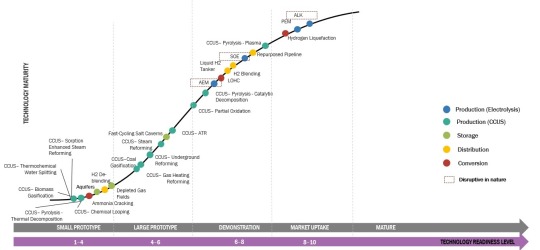
Is Hydrogen the Future or Electric?
Hydrogen Technology vs. Electric Technology
Hydrogen and electric technologies each have their own advantages and applications, thus it is likely that the future of transportation will combine both of them.
With real-world examples, uses, and benefits for both electric and hydrogen technologies, the following provides a comprehensive comparison and explanation of each:
Hydrogen Technology:
Explanation: Hydrogen technology refers to the use of hydrogen as a fuel source, typically in the form of fuel cells or combustion engines. When hydrogen is combined with air oxygen in hydrogen fuel cells to create energy, water is the only waste. This power provides a clean and efficient source of propulsion for the car's motor.
Real-world examples: Hyundai Nexo, Hyundai Clarity Fuel Cell, and Toyota Mirai.
Use cases: Heavy-duty buses, long-haul trucks, and other vehicles are among the many vehicle types that can benefit greatly from hydrogen technology since it is well-suited for applications that demand extended driving ranges and quick refueling times. Other areas where it might be helpful are remote places and mobile power solutions, where off-grid power generation and energy storage are crucial.
Hydrogen Technology Benefits:
Zero Emissions: Hydrogen fuel cell vehicles produce no pollutants from their exhaust, enhancing air quality and reducing greenhouse gas emissions.
Fast Refueling: As refueling a hydrogen-powered vehicle takes roughly the same amount of time as a conventional gasoline-powered vehicle, users will find hydrogen refueling familiar and convenient.
Long Driving Range: Hydrogen vehicles can reduce range anxiety related to electric vehicles by reaching long driving ranges that are on par with traditional gasoline vehicles.
Electric Technology:
Explanation: Electric vehicles (EVs) are powered by rechargeable batteries, which store the energy required to propel the vehicle forward. The batteries can be recharged via electric charging stations or wireless charging technology.
Real-world examples: Electric vehicles: Tesla Model S, Nissan Leaf, and Chevrolet Bolt.
Use cases: Electric technology works well for short- to medium-distance travel, personal vehicles, and urban commuting. It is being adopted more frequently by motorbikes, passenger cars, and other smaller vehicles utilized for municipal services and logistics. Electric Technology Benefits:
Zero Emissions: An electric car's tailpipe emits no greenhouse gases, greatly lowering air pollution.
Energy Efficiency: Electric motors are more effective and convert a greater percentage of stored energy into actual vehicle movement than internal combustion engines.
Renewable Energy Integration: Electric cars can serve as energy storage devices, enabling the integration of renewable energy sources, when excess electricity from renewable sources is consumed by them and returned to the grid as needed.
Lower Operating Costs: Electric vehicles usually have cheaper energy costs and require less maintenance as compared to conventional internal combustion engine vehicles. This leads to lower operating costs.
For personal cars, urban transportation, and the integration of renewable energy sources, electric technology is suitable, but hydrogen technology works best for applications that require long driving ranges and short refueling times. Certain use cases, infrastructure accessibility, and market demand all play a role in the decision between hydrogen and electric power. It is likely that a combination of electric and hydrogen technologies will be used as the transportation sector grows in order to satisfy various needs and achieve goals for sustainable mobility.
Hydrogen Potential - Revolutionizing Transportation:
Hydrogen Fuel Cell Vehicles (FCVs):
Vehicles with internal combustion engines can be replaced with emission-free hydrogen fuel cell vehicles. They use hydrogen as fuel for the vehicle, and when hydrogen and oxygen react chemically, electricity is produced, which drives the electric motor. FCVs are environmentally friendly because the only byproduct they produce is water vapor.
Fuel cell vehicles (FCVs) have the advantage of having greater driving ranges and shorter refueling times than battery electric vehicles. Hydrogen is now a viable option for heavy-duty and long-distance driving since it eliminates the range anxiety and lengthy recharge times that are usually associated with electric vehicles.
As technology advances and economies of scale are attained, it is projected that the cost of fuel cell systems and hydrogen infrastructure will decrease, expanding consumer access to FCVs.
Sustainable Aviation:
As a sustainable aircraft fuel, hydrogen is being researched by the aviation industry. By powering airplanes with hydrogen in fuel cells or combustion engines, the aviation sector can reduce its dependency on fossil fuels and carbon emissions.
Aircraft powered by hydrogen have the potential to significantly reduce noise pollution because the combustion of hydrogen is quieter than that of traditional jet engines. This could result in more environmentally friendly and silent aviation, which would be advantageous for the communities surrounding airports.
Shipping and Maritime Applications:
The marine industry, which contributes significantly to global emissions, might be decarbonized with the use of hydrogen. Internal combustion engines or hydrogen fuel cells can be used in place of conventional fossil fuel engines in ships to reduce emissions of greenhouse gases and marine pollution.
The use of hydrogen in port operations also extends to ship auxiliary power systems, cargo handling equipment, and forklifts. By converting to hydrogen-powered equipment, ports can reduce their carbon footprint and contribute to the creation of cleaner, more sustainable port operations.
Energy Storage and Grid Balancing:
Hydrogen offers a great deal of potential significance for energy storage and grid balancing. Hydrogen can be manufactured via electrolysis from excess electricity generated by renewable sources. The stored hydrogen may subsequently be converted back into electricity using fuel cells, which makes it easier to integrate renewable energy sources into the grid and ensures a consistent and reliable supply of energy.
Hydrogen can act as a buffer to lessen the intermittent nature of renewable energy sources during periods when the output of renewable energy is constrained. Because of its versatility, an energy system can be balanced and more efficient, which promotes the use of renewable energy sources and reduces reliance on fossil fuels.
All things considered, hydrogen offers zero-emission fuel alternatives for a range of vehicles, including cars, airplanes, ships, and port operations, and has the potential to totally reshape the transportation sector. Because of its advantages in terms of longer ranges, quicker recharging, and energy storage capacities, hydrogen is positioned as a major player in the future of sustainable transportation, contributing to the creation of cleaner air, lower carbon emissions, and a more sustainable energy system.
Read More-https://www.marketsandmarkets.com/industry-practice/hydrogen/hydrogen-future-electric
#HydrogenVsElectric#CleanEnergyDebate#FutureFuel#RenewableRevolution#GreenTechShowdown#ZeroEmissionsBattle#SustainableTransport
0 notes
Text
Electric Car Manufacturer
Electric cars are vehicles that use electric motors instead of internal combustion engines. They are powered by batteries, fuel cells, or other sources of electricity. Electric cars offer many benefits, such as lower emissions, reduced noise, and lower operating costs. However, they also face some challenges, such as limited range, high initial cost, and lack of charging infrastructure.
Electric vehicle (EV): A vehicle that uses one or more electric motors for propulsion.
Battery electric vehicle (BEV): An EV that uses only batteries as the source of electricity.
Plug-in hybrid electric vehicle (PHEV): An EV that uses both batteries and an internal combustion engine. The batteries can be recharged by plugging into an external power source or by the engine.
Hybrid electric vehicle (HEV): An EV that uses both batteries and an internal combustion engine. The batteries are recharged by the engine or by regenerative braking.
Fuel cell electric vehicle (FCEV): An EV that uses a fuel cell to convert hydrogen and oxygen into electricity.
Electric vehicle charging station: A device that provides electricity to charge the batteries of an EV.
Electric vehicle range: The distance that an EV can travel on a single charge of its batteries.
Electric vehicle efficiency: The ratio of the energy output of an EV to the energy input from the power source.
Electric vehicle emissions: The amount of greenhouse gases and air pollutants that are released by an EV or by the power source that charges it.
Electric vehicle incentives: The policies and programs that encourage the adoption of EVs, such as tax credits, rebates, subsidies, or exemptions.
Unveiling the Power Players: A Look at Major Electric Car Manufacturers
The electric vehicle (EV) revolution is buzzing, and at its heart lie the innovative minds and tireless efforts of dedicated manufacturers. From established giants to rising stars, each player brings unique strengths and visions to the table, propelling the world towards a cleaner, greener future.
Let's delve into the world of major electric car manufacturers through the lens of https://internationalelectriccar.com/electric-cars/manufacturer/:
Tesla: The Elon Musk-led juggernaut reigns supreme, pioneering EV technology and design with its iconic Model 3, Model S, and Cybertruck. Tesla's Gigafactories across the globe churn out these futuristic vehicles, pushing the boundaries of performance and range.
BYD: China's BYD is a formidable contender, offering a diverse range of electric cars, buses, and even trucks under its own brand and through partnerships. Their focus on affordability and innovation makes them a force to be reckoned with in the global market.
Volkswagen Group: The German automotive giant is embracing the electric future with brands like Volkswagen, Audi, Porsche, and Skoda. Their ID. series and the Porsche Taycan showcase their commitment to luxury and performance in the EV space.
General Motors: The American automaker is making a strong comeback with dedicated EV production facilities in the US and focusing on brands like Chevrolet and GMC. Their Bolt EV and Hummer EV models cater to different segments and highlight GM's diverse EV strategy.
Hyundai-Kia: The Korean duo is quickly establishing itself in the EV market with innovative models like the Hyundai Kona Electric and Kia EV6. Their focus on design, technology, and affordability makes them attractive options for a wider audience.

Beyond the Big Names:
The EV landscape extends far beyond these established players. Startups like Lucid Motors, Rivian, and Fisker are shaking things up with their high-performance EVs and cutting-edge technology. Additionally, regional players like Nissan (Leaf), Renault (Zoe), and Volvo (XC40 Recharge) are significant contributors to the global EV market.
Exploring the Future:
The electric car revolution is still in its early stages, and the manufacturers are constantly pushing the boundaries. Future developments to watch include:Battery breakthroughs: Longer range, faster charging, and more sustainable battery production are key areas of focus. Autonomous driving: Integrating advanced driver-assistance features and even fully autonomous driving capabilities are on the horizon. Greater affordability: Making EVs accessible to a wider audience through cost reductions and innovative financing options is crucial for widespread adoption.
By understanding the major electric car manufacturers and their unique offerings, we can better grasp the dynamics of this rapidly evolving industry. As technology advances and competition intensifies, the future of electric cars looks bright, promising cleaner, more sustainable transportation for all.
#electric car#electric car blogs#Exploring the Future#Major Electric Car Manufacturers#Electric Car Manufacturers#manufacturer#electric car information#global electric car market#Electric vehicle#electric vehicle blog#Battery electric vehicle#transportation#electric cars#best electric cars
1 note
·
View note
Text
EV Chargers Australia | miqenergy.com.au
The EV charging network is rapidly expanding across Australia. The country’s largest emerging charge location operator is Chargefox who operates 153 fast charging sites across the nation.
It uses Jolt DC charging stalls which are compatible with CCS and CHAdeMO plugs for most EVs on sale today, although the Tesla Supercharging network is exclusive to its vehicles.
Level 1
The bog standard wall socket that your toaster and mobile charger plug into that delivers AC power is considered a Level 1 charge point. It’s ideal for topping up your EV while you’re parked at home, office or at work but is too slow to provide a full recharge on a long road trip.
Some workplaces, shopping centres and accommodation venues have started providing Level 1 charging for EV drivers. It’s also a popular option for residential EV owners who install them in their garages or driveways.

There are plenty of connectors, adapters and converters available if you’re planning to use your Level 1 best ev chargers with a different kind of public charger. These are often required if you’re using a CCS Combo connection for DC fast charging. For more information, consult this handy EV charger map to see the locations and ports of various stations across Australia. It will also give you an idea of the power levels and driving range added per hour of charging for each location.
Level 2
Insufficient public charging infrastructure remains a valid concern for EV buyers. NRMA is working with state governments to expand the network, while Chargefox is trialling pricing models that prioritize cheaper charging during daylight and encourage the use of renewable energy.
There are also a variety of ev chargers Australia available for your home, work or commercial space. From coiled plugs that fit into standard 10amp domestic sockets to dedicated wall-mounted units with up to 22kW capacity, there is something to suit every home and business.
EV drivers can also purchase portable EV charging cables for their cars that improve safety through two-way communication between the charging station and the car. This ensures the EV is only charged at the correct voltage and speed, as well as communicating with the vehicle to avoid overcharging. These are suited to small EVs and can be used at home or public EV charging stations. Contact EVE Australia for more information on these and other EV charging options.
Fast Chargers
Australia’s EV charging network is growing quickly but is still patchy and underpowered by global standards. That could slow the country’s EV adoption rates, and deter new buyers from buying cleaner cars, industry executives say.
Australia has a broad range of slow AC chargers at businesses and council sites, with the biggest networks operated by Evie (with its teal-painted parking spaces) and EVUp. BP is also rolling out 300 of its own public DC fast-charging sites, but it’s encountering delays in connecting them to the grid due to high demand and lengthy studies required to ensure the chargers don’t overburden the power system.
The fastest chargers are Tesla’s DC Superchargers, but those are limited to the company’s Model S and X vehicles. Adaptors are available to allow them to charge other brands of EV using a CCS Combo connection. They can also enable bidirectional charging — where the car can return energy to the grid from the road, though regulations aren’t yet ready for that.
Home Chargers
EV chargers are also becoming available for use at home. These are usually level 2 chargers, and are a good option for those who want to reduce their range anxiety by having the ability to charge at home (assuming your house can accommodate a home EV charging station).
A home EV charger will typically have a Type 2 plug, which is compatible with all EVs on the Australian market. You’ll find that most new EVs will come with this plug, and older vehicles will require a Type 2 to Type 1 adapter cable.
A home charger rated at 7.2kW costs around $950 to $1500 plus installation, and many car manufacturers offer bundled installations with the purchase of an EV. Many of these chargers are connected to renewable solar energy, which means that the cost of charging your EV at home is effectively zero. That’s a pretty great deal.
1 note
·
View note
Text
Starrk – ’68 Cadillac DeVille (convertible, white walls, stacked headlights, smooth, comfortable –makes a perfect spot for napping in the sun—what more can you ask for?)
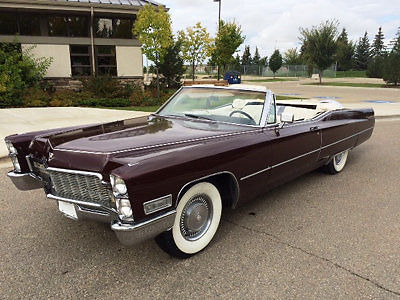
Barragan – Hummer H1 Alpha Wagon (I really considered a town car because he’s got the king motif, but I refuse to believe that man would settle for anything short of a road-legal monster truck, so)

Harribel – Tesla Model S P100D (this car could kick my car’s ass. it has its own biowarfare defenses.)

Ulquiorra – 17’ Bolt EV (small, quiet, he wouldn’t have to stop at gas stations often –perfect.)

Nnoitra – Harley V-rod (if you think his awful little man is going to arrive in anything less than the loudest, most over-painted hog EVER, LOUNGING while he judges you, you’re wrong my dude.)
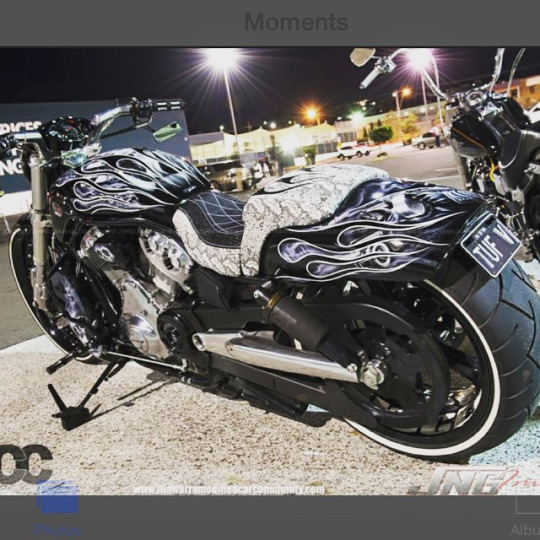
Tesla, for what it’s worth, has a Harley Softail Trike:

Grimmjow – Jaugar F-Type SVR (v8, all wheel drive, black leather interior with blue detailing)

Zimmaro – 17’ Prius 3 Touring (probably too cool of a car for this dude, but it’s quiet and efficient. this bitch has cloth seats and a suede wheel cover)
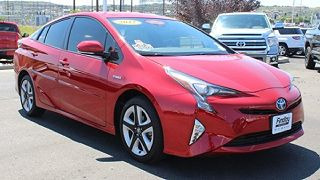
Szayel Aporro – Volkswagen T4 (as big and as useful as you can get without paying an import tax. he drives a creeper van –except with a meticulous paint job: two-tone (pictured below) except orange=grey with pink pearl)

Aaroniero – 94’ Chevy S10 Blazer (indulge me. imagine it. imagine his giant head.)

Yammy – F-150 Raptor (in all reality he’s gonna rip the doors off and only use the seatbelts to make sure his puppy doesn’t go flying when he cuts people off in traffic.)

Dordoni – 69’ El Camino SS (give this man a V8 and a manual transmission. Give him the classic two-tone. These are my FAVORITE cars my friends. My 80’ doesn’t hold a candle to the beauty of a 69’ the angle of that front is to DIE for.)
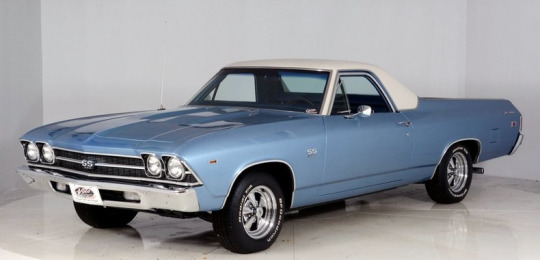
Cirucci – Jeep Wrangler JK Sport (she’ll just run over the people who get on her nerves. plus she can take off the doors and show off those legs, and it comes in Xtreme purple)

0 notes
Text
Travis Barker Net Worth

Travis Barker Net Worth
According to Celebrity Net Worth, Travis Barker Net Worth is estimated to be around $50 million. He has accumulated his wealth through his successful music career, business ventures, and other ventures.
Barker's work with Blink-182 has been one of his most significant sources of income. The band's successful albums and tours have helped him earn millions of dollars over the years. Barker has also earned money through his solo projects, collaborations, and other business interests.
In addition to his financial success, Barker has also received critical acclaim for his work. He has been nominated for and won several awards, including a Grammy Award for Best Rock Album for Blink-182's "Take Off Your Pants and Jacket."
Travis Barker’s Assets & Investments
Real Estate Investments
One of Barker's most significant investments has been in real estate. He owns several properties in California, including a $4.8 million mansion in Calabasas and a $2.8 million home in Cheviot Hills. He has also invested in commercial properties, including a music studio in Burbank.
Other Business Ventures
Barker has also invested in other businesses, including a vegan restaurant called Crossroads Kitchen and a CBD oil company called Barker Wellness Co. He has also partnered with companies such as Zildjian Cymbals and Drum Workshop.
Travis Barker Net Worth Growth Rate
Travis Barker's net worth has grown significantly over the years due to his successful music career and business ventures. While exact figures vary, it's estimated that his net worth is around $50 million as of 2023.
Music Career
Barker's music career has been the primary source of his wealth. He rose to fame as the drummer for the band Blink-182, which sold over 50 million records worldwide. He has also collaborated with other musicians and bands, including Transplants, Box Car Racer, and +44.
Barker has also worked as a producer and remixer for various artists, including Pink, The Black Eyed Peas, and Yelawolf. He has won multiple awards for his music, including a Grammy Award for Best Rock Album in 2011.
Business Ventures
In addition to his music career, Barker has made smart investments in various businesses, as we have discussed before. His clothing lines, real estate investments, and partnerships with companies have contributed significantly to his net worth growth.
Travis Barker Business (Famous Stars and Straps)
Founding of Famous Stars and Straps
Barker was inspired to create Famous Stars and Straps as a way to combine his love for music and fashion. The brand's logo, which features a stylized "F" and "S" with a star in the middle, quickly became popular among fans of punk rock and streetwear.
Expansion of the Brand
Over the years, Famous Stars and Straps has expanded to include a wide range of clothing and accessories, including t-shirts, hoodies, hats, and bags. The brand has also collaborated with other companies, such as Vans and DC Shoes, to create limited edition footwear and apparel.
Brand Philosophy
Famous Stars and Straps is more than just a clothing line; it's a lifestyle brand that reflects Barker's personal philosophy. The brand's motto, "Family, Loyalty, and Respect," emphasizes the importance of relationships and staying true to oneself.
Travis Barker’s Cars
Travis Barker the famous drummer of Blink-182, is known for his love of cars and has a collection of high-end vehicles. Some of the cars in his collection include:
Mercedes-Maybach S 650: This luxurious sedan is one of the most expensive models in Barker's collection, with a starting price of over $200,000.
Rolls-Royce Phantom Drophead Coupe: This convertible luxury car is one of the most unique vehicles in Barker's collection and is valued at over $400,000.
Cadillac Escalade ESV: This large SUV is often used to transport Barker and his family and has been customized with a sound system and other modifications.
Tesla Model S: This electric vehicle is a more eco-friendly option in Barker's collection and has a sleek and modern design.
1956 Ford F-100: This classic pickup truck is one of Barker's favorite vehicles and has been restored with modern features while maintaining its vintage charm.
Overall, Travis Barker's car collection is a reflection of his love of luxury and unique vehicles. His collection includes both modern and classic cars, and many of his vehicles have been customized with unique features and modifications.
Travis Barker Liabilities and Loans
Travis Barker, the American musician and drummer, may have various liabilities and loans as a result of his personal and professional activities.
Liabilities refer to any debts or financial obligations that Travis Barker may owe to others, such as credit card debt, mortgages, car loans, or unpaid taxes. These liabilities could have resulted from his personal expenses or his business ventures, such as record labels, music tours, or clothing lines.
Similarly, Travis Barker may have taken out loans to finance his various projects, such as purchasing equipment, studio time, or investing in businesses. These loans may have been obtained from banks, private lenders, or investors, and will likely have associated interest rates and repayment terms.
As a public figure and successful musician, Travis Barker may have a team of financial professionals who help manage his assets and liabilities. However, without specific information about his financial situation, it is impossible to know the exact nature and extent of his liabilities and loans.
0 notes
Text
Episode 789 - Interview Bill EV TJ
I'm just a simple guy with a welder and a garage. introduction to Jeeps started as early as I can remember on my families farm taking our John boat down to the river on a rickety old trailer in an equally rickety old 1964(ish) CJ3B. When I was 16 I swept all the barn dust off of the old CJ and commenced on a sympathetic (that is to say cheap) restoration actually getting it onto public streets! 30 years later, I got a hold of a 1997 Wrangler and started converting it to electric. The motor, transmission and battery is out of a salvaged Tesla Model S P90. The conversion rolled out of the garage about a year later but was, unfortunately, pushed back in the garage about an hour later. It'd be another 6 months before It left the garage again. Now, over a year later, it's still going strong!
Check out this episode!
0 notes
Link
0 notes
Text
Can you run electric off a car battery?
An increasing number of people are looking into ways to power their homes and businesses with electricity generated from alternative sources, such as solar panels or wind turbines. But what about powering a car? That's where battery-powered electric cars come in.
Electric vehicles are becoming more popular every year, and the number of registered battery-powered cars has more than tripled in the past five years. But there is one big downside to electric vehicles: you need a steady supply of electricity to power them.
How does an electric vehicle work?
According to Battery Query, an electric vehicle, such as a Tesla Model S, is powered by electricity from batteries instead of gasoline. The battery powers an electric motor, which turns the car's wheels. Electric cars are much quieter than gasoline cars and they emit no pollutants from the tailpipe.

Electric cars are becoming more popular each year. But how do they work? How do you charge them? And what’s the difference between electric and gasoline cars? We’ll answer all those questions and more in this article. Electric vehicles are becoming more popular each year and with good reason. They have a number of benefits, including being environmentally friendly and providing a comfortable ride. But what about charging the battery? There are a number of ways to do this, but one of the most common is to use a car battery. Can you run electricity off a car battery?
Yes, it's possible to run electric off of a car battery if you have the right equipment. The biggest challenge is finding an appropriate battery pack and inverter.
Can you run electric off a car battery?
Electric vehicles are gaining in popularity, but many people still don't know if they can run off of a car battery. The answer is yes - you can. However, the range and performance of an electric car may vary depending on the type of battery and how it's being used.
You can use your generator to charge your car battery. But there are some things you need to know first. First, you need an inverter or alternator that has the capability of taking DC voltage and changing it into AC voltage.
How long will the car battery last?
The life of a car battery is determined by many factors. Temperature, the age of the battery, how often it is used and how it is maintained all play a role in how long the battery will last. Generally speaking, a car battery will last 3 to 5 years. However, if the battery is not used often, it may last longer. Conversely, if it is used frequently, it may not last as long.
Temperature also plays a role in how long the battery lasts. Extreme cold or heat can reduce the life of the battery. In order to get the most out of your car battery, you should try to keep it in a moderate temperature range.
Another factor that affects the life of a car battery is how well it is maintained.
What are some alternative ways to power an electric vehicle?
Electric vehicles are becoming more popular as people become more environmentally conscious. However, the reliance on traditional power sources to charge these vehicles can be a deterrent for some. Luckily, there are a number of alternative ways to power an electric vehicle.
These include charging the car with solar energy, using wind power, or even converting the vehicle to run on hydrogen fuel cells. Each of these methods has its own benefits and drawbacks, so it is important to consider all of them before making a decision about which one is right for you.

Electric cars have been on the market for a few years now, and many people are interested in learning if they can run off of a car battery. The short answer is yes, you can run electric cars off of a car battery. However, there are some considerations that must be made before doing this. First, you need to make sure your car has the necessary wiring to connect the battery to the power supply. Second, you need to make sure your battery is strong enough to power your car.
Conclusion
Electricity has been a part of our everyday lives for so long now that it's hard to imagine life without it. But what if you couldn't rely on the power grid? What if you had to run your electric devices off of your car battery? Well, that's not a problem anymore! In fact, there are many ways to run electric off of a car battery and stay connected. Here are six ways to do it:
1 note
·
View note
Text

Is Hydrogen the Future or Electric?
In the future of energy and transportation, depending on the specific application and context, both electricity and hydrogen will play important roles. It's a vibrant and intricate subject, though.
Hydrogen Technology vs. Electric Technology
Given the benefits and uses of both electric and hydrogen technologies, it is conceivable that they will be combined in transportation systems of the future.
Download - https://www.marketsandmarkets.com/industry-practice/RequestForm.asp
A detailed explanation of hydrogen and electric technologies is given below, along with real-world examples, uses, and benefits of each:
Hydrogen Technology:
Explanation: Hydrogen technology refers to the use of hydrogen as a fuel source, typically in the form of fuel cells or combustion engines. When hydrogen is combined with air oxygen in hydrogen fuel cells to create energy, water is the only waste. This power provides a clean and efficient source of propulsion for the car's motor.
Real-world examples: Toyota Mirai, Hyundai Nexo, and Honda Clarity Fuel Cell.
Use cases: Hydrogen technology works flawlessly for a variety of vehicle types, including long-haul trucks, heavy-duty buses, and other vehicles that require extended driving ranges and quick refilling intervals. It might also be helpful in areas like off-grid power generation and energy storage for remote sites and mobile power solutions.
Hydrogen Technology Benefits:
Zero Emissions: Hydrogen fuel cell vehicles emit zero tailpipe emissions, contributing to a reduction in greenhouse gas emissions and an improvement in air quality.
Fast Refueling: Refueling a hydrogen vehicle is simple and familiar for users because it takes roughly the same amount of time as refueling a conventional gasoline vehicle.
Long Driving Range: Although range anxiety can occasionally be experienced with electric vehicles, hydrogen vehicles can achieve long driving ranges comparable to that of traditional gasoline-powered automobiles.
Electric Technology:
Explanation: Electric vehicles (EVs) are propelled forward by rechargeable batteries that store energy. Battery recharging can be accomplished by wireless charging technology or electric charging stations.
Real-world examples: Tesla Model S, Chevrolet Bolt EV, and Nissan Leaf.
Use cases: Electric vehicles are a suitable fit for short- to medium-distance driving, urban commuting, and private vehicles. Motorbikes, passenger cars, and other smaller vehicles used for logistics and municipal services are starting to use it more frequently.
Electric Technology Benefits:
Zero Emissions: Electric vehicles offer zero tailpipe emissions in addition to drastically lowering greenhouse gas emissions and air pollution.
Energy Efficiency: Electric motors convert stored energy into actual vehicle motion more effectively than internal combustion engines do.
Renewable Energy Integration: Electric vehicles can help integrate renewable energy sources by serving as energy storage devices that allow them to use extra electricity from renewable sources and return it to the grid when needed.
Lower Operating Costs: Electric vehicles frequently have cheaper running costs than their conventional internal combustion engine counterparts since they require less energy and maintenance.
Hydrogen technology is well suited for applications needing long driving ranges and quick refueling times, whereas electric technology is appropriate for personal vehicles, urban commuting, and the integration of renewable energy sources. The choice between hydrogen and electricity is impacted by specific use cases, infrastructure accessibility, and market demand. As the transportation sector grows, a combination of both hydrogen and electric technologies will likely be used to suit a variety of needs and achieve sustainable mobility objectives.
Hydrogen Potential - Revolutionizing Transportation:
Hydrogen Fuel Cell Vehicles (FCVs):
The zero-emission hydrogen fuel cell car can replace internal combustion engine vehicles. They use hydrogen as fuel for the vehicle's electric motor, which produces electricity through a chemical reaction with oxygen. Since water vapor is the only byproduct, FCVs are advantageous for the environment.
Fuel cell vehicles, or FCVs, have longer driving ranges and require less time to refuel than battery-electric vehicles. As a result, hydrogen becomes a viable option for heavy-duty and long-distance driving, potentially alleviating the range anxiety and lengthy recharging times that are often connected with electric vehicles.
Fuel cell vehicles (FCVs) are expected to become more inexpensive for customers as technology advances and economies of scale are realized. This will result in a drop in the cost of fuel cell systems and hydrogen infrastructure.
Sustainable Aviation:
Hydrogen is a sustainable aircraft fuel source that the aviation industry is looking into. One way to reduce carbon emissions and the aviation sector's dependency on fossil fuels is to power airplanes using hydrogen via combustion engines or fuel cells.
Aircraft fueled by hydrogen have the potential to drastically cut down on noise pollution because their combustion produces noise levels that are lower than those of normal jet engines. In addition to reducing noise pollution and improving environmental sustainability, this could benefit the local communities near airports.
Shipping and Maritime Applications:
Hydrogen possesses the ability to aid in the decarbonization of the maritime industry, which is a significant source of emissions globally. Internal combustion engines or hydrogen fuel cells can be used in place of conventional fossil fuel engines in ships to reduce emissions of greenhouse gases and marine pollution.
Applications for hydrogen can be found in port operations, such as forklifts, cargo handling equipment, and ship auxiliary power systems. By converting to hydrogen-powered equipment, ports can reduce their carbon footprint and contribute to the creation of cleaner, more sustainable port operations.
Energy Storage and Grid Balancing:
Hydrogen can play a major role in grid balance and energy storage. Hydrogen can be made from excess electricity generated by renewable sources through an electrolysis process. The hydrogen that has been stored can then be converted back into electricity through the use of fuel cells, which will help to enable the integration of renewable energy sources into the grid and offer a consistent and reliable supply of energy.
Hydrogen can act as a buffer when the generation of renewable energy sources is low, as they are unpredictable. This flexibility promotes the adoption of renewable energy sources and reduces reliance on fossil fuels, improving the efficiency and balance of the energy system.
All things considered, hydrogen offers zero-emission fuel alternatives for a range of vehicles, including cars, airplanes, ships, and port operations, and has the potential to totally reshape the transportation sector. Because of its advantages in terms of longer ranges, quicker recharging, and energy storage capacities, hydrogen is positioned as a major player in the future of sustainable transportation, contributing to the creation of cleaner air, lower carbon emissions, and a more sustainable energy system.
Read More - https://www.marketsandmarkets.com/industry-practice/hydrogen/hydrogen-future-electric
#HydrogenVsElectric#CleanEnergyDebate#FutureFuel#GreenTech#RenewableRevolution#HydrogenEconomy#ElectricVehicleDebate#SustainableTransport#EnergyTransition
0 notes
Text
Teslas, be it Model S, X, 3, or Y, are beyond smart, almost intelligent. However, Tesla’s bouquet of technological features can overwhelm many fans. Most people need a while to become familiar with the scores of evolving attributes, including keys, fobs, and key cards. So how can you unlock a Tesla?
Tesla officially offers four ways to unlock your car: keys, fobs, key cards, and a smartphone app. Unofficially, you may try Tesla key card or fob alternatives like rings or bracelets. All methods have pros and cons, and you can use every mechanism for your convenience.
The latest Tesla models don’t have a key fob unless you purchase it separately. The default unlocking methods are the key card and your smartphone, either through the app or Bluetooth. This guide unlocks all the technicalities you should know about Tesla’s keys, fobs, and key cards.
How To Unlock and Lock a Tesla
Tesla uses four technologies to unlock and lock its Models 3 and Y. The latest versions of the earlier flagship Models X and S can also support these mechanisms.
Let’s go over each one of these methods below.
1. Use Tesla Key Cards
The key card is Tesla’s primary and default access mechanism. Tesla introduced the short-range radio-frequency identification sensor in Model 3, located just below the side camera next to the front door. The key card has a chip and antenna inside.
Place or tap the key card over the sensor in the frame to unlock and lock your Tesla. You’ll hear two honks when you unlock, and one after you lock the car. A pair of key cards is included in the package when you purchase a Tesla. You must add the second key card.
Tesla Key Card Pros
Slender and light. You can pair several key cards for family and friends.Easy to add, remove, and manage.
Tesla Key Card Cons
You must tap the key card physically.The key card doesn’t facilitate passive lock or unlock.The material isn’t sturdy enough for rough handling.
2. Use Tesla’s Smartphone App
Tesla’s official smartphone app provides remote access to your car, allows you to lock and unlock your car, and offers several other controls. After activating your account, which may take around 48 hours, you can start using the remote access and other controlling features.
You need a smartphone app, an internet connection, and an activated Tesla account to convert your phone into a Bluetooth key. Plus, you need to follow the same process for every new Tesla app account for family and friends.
Tesla Smartphone App Pros
Effortless remote access.Lock, unlock, and restrict access to selected settings.App-based climate control and navigation, etc.
Tesla Smartphone App Cons
Dependent on the internet.Access is limited to phones with the app and activated accounts.The app doesn’t facilitate passive lock or unlock.
You need the original authenticated key card to add or pair and authorize any new phone key, fob, or alternatives. The only way to program the original key card is by visiting a service center. Also, Tesla key fobs are preprogrammed, but third-party alternatives generally have blank chips.
Photo by Manny Becerra on Unsplash
3. Use Your Phone
You can use your phone as a Tesla key. Turn on the phone’s Bluetooth and pair it with the car. Before that, you need to download the smartphone app and get your username and password registered with Tesla to activate your account and add the phone.
Once paired, the phone serves as a standalone key, independent of the Tesla app, the key card, and key fobs—the latter only when or if you purchase. Tesla allows you to add up to 19 keys, including phones, cards, and fobs. Hence, you can convert several phones into Tesla keys.
The most noteworthy advantage of using a phone key is convenience. You don’t have to place the Tesla key card on the sensor to unlock or lock. The phone’s proximity locks and unlocks the car, so you will hear a single or double honk as you walk towards or away from the Tesla.
Phone Key Pros
Hands-free lock and unlock.Automated lock and unlock based on proximity.You can add several phone keys.Easy to add, remove, and manage.
Phone Key Cons
You need the phone at all times.The phone must have a sufficient charge.The Bluetooth must be on for auto lock and unlock.Auto-lock and unlock efficiency varies for phones.
4. Use Tesla Key Fobs
Tesla key fobs are an official aftermarket accessory. You can buy a key fob from Tesla for around $150 to $175. Unlike key cards, you don’t get a pair of fobs. You can sync a key fob in the same way you would add a new phone or card.
In addition to locking and unlocking at close proximity, Tesla key fobs can also operate the trunks at the back and front. Double-click a Tesla key fob to unlock and single-click to lock the door and the rear or front trunk. You can add a maximum of four fobs among the 19 keys.
Tesla Key Fob Pros
A conventional option to lock and unlock.You can lock and unlock the trunks, too.Water-resistant and sturdier than the key card.Model Y fobs with the Tesla logo facilitate passive lock and unlock.
Tesla Key Fob Cons
You need to click once or twice for the fobs with the Model 3 logo.Model 3 fobs don’t facilitate walk-away auto lock or passive entry.Each key fob costs significant money.The key fobs must be programmed by Tesla.
Anyway, on a similar note, I also wrote a somewhat related article and discussed the question if EVs Have and Need Keys. Have a look to find some valuable info! Let me know what you think.
Tesla Key Card and Fob Alternatives
Tesla key and fob alternatives that are compatible with the same short-range radio-frequency technology as the official cards have a chip and antenna. You can buy an alternative or make your own using the key card components.
The Tesla key fob alternatives are third-party accessories. Thus, the embedded chips and other technologies may or may not be compatible with your Tesla, which could be due to a specific issue with a model or the tech. Also, the accessories function differently from the Tesla key and fobs..
You can pair the alternatives in the same way you add your phone and a Tesla key fob or card. The device will appear as an unknown key, and you can save it using a preferred name.
Here are a few readymade Tesla key fob alternatives on Amazon.com:
Products
Attributes
CNICK Tesla Key Ring
CNICK Tesla Key Bracelet
COLMO Model 3 Smart Ring
KIMISS Car Smart KeyForm FactorRingBraceletRingRingMaterialWoodWood and StonesCeramicCarbon FiberSizeUS: 6 to 10, and 1316cm to 21cm (6.3in to 8.3in)7mm and 9mm (0.27in and 0.35in)US: 6 to 12Colors344 & CustomBlack & RedTesla Models3 and Y3 and Y33, X, S, Y
DIY Tesla Key Card or Fob Alternative
The Tesla key card is essentially a plastic case for a copper-wire antenna and radio-frequency identification chip. You can remove the plastic, extract the chip and antenna, bend, or reshape it while ensuring it still works to fit into any form factor and make a DIY key.
Here’s an excellent video of taking a Tesla key card apart and testing the chip & antenna:
https://www.youtube.com/watch?v=ZfyiYCmU1_8
How Do You Drive a Tesla Without a Key Card?
You can drive a Tesla without a key card by using your paired phone, access the system through the official app, or buy a fob from Tesla. The key card and fob alternatives, such as rings or bracelets, are an option. However, verify if the third-party solutions can work seamlessly with your Tesla.
You don’t need a key card to drive a Tesla. If you’re using any other paired keys, such as phone, app, or fob, you can unlock and lock your car, thus powering the system on and off, respectively. Once inside, press on the brake, then put the car into gear and drive.
The only instances when you’ll need your key card are if you have to pair a new device, remove an existing fob, add another phone, don’t have any phone key, or manage different systems synced with the Tesla.
Also, you can set a pin to drive for additional security.
Set a Pin To Drive
Pin to Drive is a security feature to prevent unauthorized access to the system. Unlocking a Tesla gives you access to the control panel. A key card is required again only when you authorize significant changes or the system powers off in the absence of a paired phone or fob.
Here’s a quick 2-minute video showing how you can set a pin to drive on Tesla Model 3:
https://www.youtube.com/watch?v=-5hHdl83ylU
How To Activate a Tesla Key Card
Your first key card should be activated when your Tesla is delivered or at the service center. Subsequently, you can use the first authenticated and activated key card to add all other keys, be it another card, your and others’ phones, a Tesla fob, or any alternative you may choose.
Take these steps to add and activate a Tesla key card:
Access the Menu on the Tesla touchscreen.Tap on Controls > Locks > +. Scan the new key card on the center console.Scan the original authenticated key card to authorize.The new card will show up as an unknown key.Rename it and exit.
Can You Use Your Phone as a Key for Tesla?
You can use your phone as a Tesla key if it’s paired with the system through Bluetooth. Download the Tesla app on the phone, log in using registered details, add the device through the touchscreen Menu and Locks, and activate it using an authenticated key card.
The same process of adding and activating a key card applies to pairing a phone, Tesla key fob, or alternatives. Adding a phone as a key requires authentication through the Tesla app in addition to key card authorization. Add key fobs by scanning them in the same way as cards.
Here’s a stepwise video tutorial on adding and activating Tesla key cards and phones:
https://www.youtube.com/watch?v=9u1MXoSEj_s
How Do You Start a Tesla Without a Key?
You can start a Tesla without a key using your phone, a smartphone app, and a fob. The primary key card is required during setup, but you can use your smartphones for passive lock and unlock. Also, you can use Tesla’s app for instant access and 19 keys, including several phones, cards, and fobs.
Every authorized method serves as a standalone access mechanism. You don’t need to rely on any particular key as all the 19 keys coexist and can function independently. Let us consider a few scenarios to elaborate.
You can use your paired phone’s Bluetooth for passive entry (auto-unlock and lock).You can use the Tesla app to lock, unlock, start, summon, and control many settings. You can ask someone you trust to use the app if you lose your smartphone.You can download the app on someone’s smartphone, if available, and log in for access.You can use a Tesla key, card, or fob alternative as a backup or primary entry mode.
Can I Drive a Tesla Without the Key?
You can drive a Tesla without the key by accessing the system through the app. Also, you can start driving using your phone key, a card and fob alternative, or if the car is unlocked. Set a Pin-to-Drive if you intend to keep your Tesla unlocked and unattended.
Would you like to know How To Lock Your Tesla While Charging? Check out this helpful article that I wrote.
How To Keep Tesla Unlocked
To keep Tesla unlocked, disable the walk-away auto-locking feature or unpair your phone key and passive fob. Key cards and fobs not facilitating passive entry won’t auto-lock your Tesla. Also, you may save the GPS location of your house, go to Locks, and choose Exclude Home.
You can enable or disable auto-locking features for every driver profile. Hence, using a phone as your key doesn’t necessarily compel you to use the passive entry and walk-away locking.
Here’s a video detailing how you can change the auto-lock and related settings:
https://www.youtube.com/watch?v=SR9c5as9DGk
You must be precise with the GPS location if you choose to Exclude Home through Locks for your Tesla to stay unlocked in the garage or driveway.
The navigation system can be somewhat lenient with the range or precise coverage area. Your car may inadvertently stay unlocked where you don’t want it to be readily accessible.
It isn’t clear how much linear distance or radius Tesla considers as the proximity of your home’s location to execute this function. Some owners reported glitches when their Teslas remained unlocked even when they were several hundred meters away from their house.
0 notes
Text
Tesla Model S Convertible
Tesla Model S Convertible
A breathless session saw a quite staggering 23 cars blanketed by just eight tenths of a second with positions changing at almost every moment. Such was the competitiveness that the ballast-laden VW of Jason Plato could only manage 22nd on the grid, although the double champion has cited an as yet unknown problem with his Team BMR RCIB Insurance machine. Jason Plato, right after the…

View On WordPress
0 notes